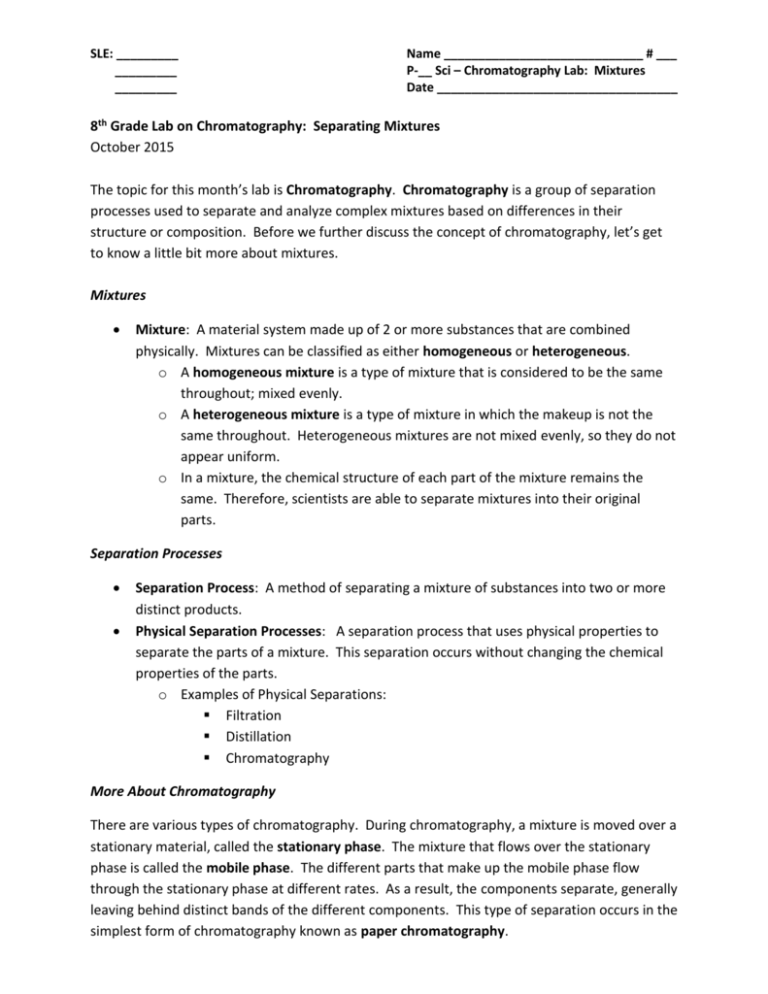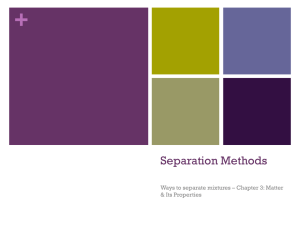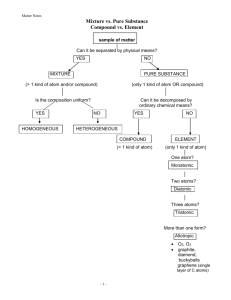SLE: ______ Name # ___ ______ P-__ Sci – Chromatography Lab
advertisement

SLE: _________ _________ _________ Name _____________________________ # ___ P-__ Sci – Chromatography Lab: Mixtures Date ___________________________________ 8th Grade Lab on Chromatography: Separating Mixtures October 2015 The topic for this month’s lab is Chromatography. Chromatography is a group of separation processes used to separate and analyze complex mixtures based on differences in their structure or composition. Before we further discuss the concept of chromatography, let’s get to know a little bit more about mixtures. Mixtures Mixture: A material system made up of 2 or more substances that are combined physically. Mixtures can be classified as either homogeneous or heterogeneous. o A homogeneous mixture is a type of mixture that is considered to be the same throughout; mixed evenly. o A heterogeneous mixture is a type of mixture in which the makeup is not the same throughout. Heterogeneous mixtures are not mixed evenly, so they do not appear uniform. o In a mixture, the chemical structure of each part of the mixture remains the same. Therefore, scientists are able to separate mixtures into their original parts. Separation Processes Separation Process: A method of separating a mixture of substances into two or more distinct products. Physical Separation Processes: A separation process that uses physical properties to separate the parts of a mixture. This separation occurs without changing the chemical properties of the parts. o Examples of Physical Separations: Filtration Distillation Chromatography More About Chromatography There are various types of chromatography. During chromatography, a mixture is moved over a stationary material, called the stationary phase. The mixture that flows over the stationary phase is called the mobile phase. The different parts that make up the mobile phase flow through the stationary phase at different rates. As a result, the components separate, generally leaving behind distinct bands of the different components. This type of separation occurs in the simplest form of chromatography known as paper chromatography. About the Experiment In this experiment, different solutions are made by mixing water with different colors and amounts of food coloring. Next, a chromatography process is used to separate the different parts of the different solutions. When the end of the filter paper is placed in a solution, the paper will begin to absorb the liquid. As the solution moves up the paper, the different color components move through the paper at different rates. As a result, the colors separate, leaving bands of color along the paper based on how far that color component can travel through the paper. Food coloring is a type of food additive that makes food a certain color (or makes the color more vibrant). People have been adding coloring to food for thousands of years to enhance the appeal of the food, either by making it appear more familiar, or simply for decoration. Food colorings were initially developed using spices, crushed seeds, or even crushed insects! However, more recently, chemists have developed synthetic food colorings to create even brighter colors and colors that are hard to find in nature. Different colors and food-coloring products contain a variety of chemical compounds, so there is not one exact formula. Hypothesis: Different food colorings and water can be combined to create uniform solutions. When the edge of the strip of filter paper is placed in the solution, the different colors of the solution will flow through the paper at different rates and separate into different bands of color on the paper. You will NEED the following items for this lab: Safety goggles (MUST be on when you enter the lab) Pencil and eraser Long hair MUST be secured into a bun prior to entering the lab. This lab preview as a supplement to the lab procedure. Your iPad if you have one TO AVOID WARRANTING AN INFRACTION, PLEASE ADHERE TO ALL SAFETY INSTRUCTIONS THAT WERE GIVEN AT THE BEGINNING OF THE SCHOOL YEAR. THIS INCLUDES ARRIVING TO CLASS PREPARED AND ON TIME, FOLLOWING ALL LAB PROCEDURES, STORING POSSESSIONS AS INSTRUCTED, ETC. WE DO NOT LIKE TO GIVE OUT INFRACTIONS, BUT INFRACTIONS WILL BE ISSUED FOR SAFETY VIOLATIONS. You will NOT need the following items: Food or drinks (including gum/mints and bottled water) Loose fitting jackets/sweaters/sweatshirts Extra books, bags/purses, etc. References: “You Be the Chemist” Activity Guide (Teacher resource center www.chemed.org)“The HPLC User’s Guide” ©1999







